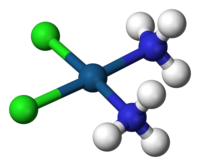
Photo from wikipedia
Abstract Coordination cages with well-defined cavities have attracted sustained attention for their applications in many fields, including host-guest chemistry, molecular recognition, and catalysis, due to their structural aesthetics and unique… Click to show full abstract
Abstract Coordination cages with well-defined cavities have attracted sustained attention for their applications in many fields, including host-guest chemistry, molecular recognition, and catalysis, due to their structural aesthetics and unique properties. This review covers the achievements in the catalytic application of these materials in specific chemical transformations. The developments in the utilizations of the coordination cages themselves as catalysts and their abilities to encapsulate catalytic cofactors for catalysis are summarized. In addition, the current challenges and great application potential of coordination cages in catalysis are discussed.
Journal Title: Coordination Chemistry Reviews
Year Published: 2020
Link to full text (if available)
Share on Social Media: Sign Up to like & get
recommendations!